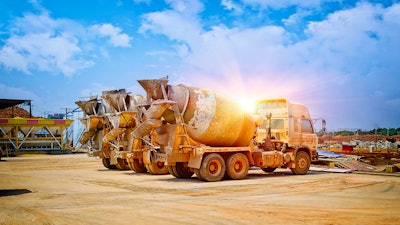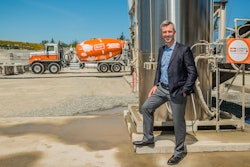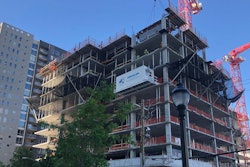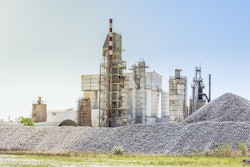
As concrete continues to be the dominant building material of the modern world, one of the largest contributors to climate change are the carbon emissions from the production and use of concrete—which accounts for 7-8% of global emissions. According to the UN, 68% of the world’s population is expected to live in urban areas by 2050, nearly doubling from today’s figure. Considering the infrastructure, in the form of buildings, roads, bridges and sewerage systems needed to support this growth, decarbonizing cement and concrete is clearly a pressing issue.
Until now, the focus on CO2 reduction in buildings has been on reducing CO2 from operations—from the energy to heat, cool, and operate buildings. But as our buildings become more efficient, the embodied carbon impact looms comparatively larger: in a very energy-efficient building, the carbon emissions from construction can exceed the CO2 from 10 years of building operations. Tackling embodied carbon will thus be an important part of getting our buildings to net-zero by 2050. This area of the concrete sector has to date had little investment or innovation, but this is starting to change, with many new innovations and technologies emerging with the potential to create carbon-negative materials, and attracting considerable interest from investors.
An International Concrete Standard for CO2
The use of lower embodied carbon concrete has been limited by a lack of a single standard to measure and report concrete CO2 intensity. To overcome this issue, over the last two years, a group of industry and NGO experts joined leading academics from Stanford, MIT, and U Michigan to develop the first international standard for a single clear specification for the amount of CO2 in concrete, as measured in pounds per cubic yard (or kilograms per cubic meter).
More on Sustainability
Find more articles and expert insight on sustainability at ForConstructionPros.com/Sustainability.
The standard, CarbonStar, was initially developed for the US and Canada and provides governments and corporations with a rigorous, transparent way to quantify, specify, and then reduce the carbon intensity of concrete based on a standard simple way to measure and report CO2 intensity. The calculation takes into account both the emitted and sequestered carbon per unit of concrete.
CarbonStar was developed to help limit global warming to 1.5º C by 2050, on the basis that one of the most powerful tools that governments have available to them is procurement—particularly for concrete as the largest purchasers of the material globally.
 Adobe Stock Images | By STOCKSTUDIO
Adobe Stock Images | By STOCKSTUDIO
CarbonStar in Practice
The San Francisco International Airport (SFO) has completed the updating of its Sustainable Planning, Design and Construction Standards that will strengthen its position as one of the world’s greenest airports and is using CarbonStar in a transformative way to deeply cut the warming impact of concrete to be used on upcoming building and infrastructure projects. SFO’s standard for concrete in its next round of construction specifies three levels of CO2 intensity for concrete using the CarbonStar rating system: good (minimum requirement) at no more than 200 pounds of CO2 per cubic yard (equal to 119 kilos per cubic meter), better (reach goal) at zero pounds of CO2 per cubic yard, and best (regenerate goals) at or below negative 200 pounds of CO2 per cubic yard. The good level—200 pounds per cubic yard is 60% below the current industry average.
This is a huge milestone for the concrete industry and a turning point for the entire construction industry’s impact on climate change. In addition, when the actual product is delivered to the construction site, the concrete manufacturer will be required to provide an Environmental Product Declaration (EPD) for their concrete mix and to document their EPDs on the Embodied Carbon in Construction Calculator (EC3) dashboard, allowing the Airport to record embodied carbon for its building, infrastructure, and tenant projects.
More on Decarbonizing Construction, Cement & Concrete
Guidelines on Embodied Carbon in Concrete - What New York’s low embodied carbon concrete bill means for concrete contractors and how an online calculator can help.
Concrete: A Sponge for Carbon Dioxide - Rick Bohan of the Portland Cement Association explains the concept and science of concrete acting as a carbon sink.
Propane-powered Vehicles Offer Lower Carbon Footprint than EVs in Many States
The PCA’s Roadmap to Carbon Neutrality and what concrete might just look like come 2050.
The goals presented and the steps to take regarding the PCA’s Roadmap to Carbon Neutrality.
Discussing the Concrete and Construction links in PCA’s Carbon Neutrality value chain.
Astec & CarbonCure Partnership to Accelerate Sustainability in the Concrete Industry - CarbonCure's technology reduces embodied carbon by injecting CO2 during the batching process, sequestering it within the concrete. CarbonCure’s scalable, sustainable concrete technology has been installed in more than 400 concrete plants around the world.
The really remarkable part of SFO’s concrete standard is the zero and negative CO2 thresholds—this marks the commercial reality that we can for the first time use concrete to sequester carbon—and make concrete part of the climate solution rather than a major part of the climate problem. Five years ago, SFO demonstrated the first commercial use of carbon sequestering aggregate from the firm Blue Planet.
Today, with the increased pressure of climate change there is a surge in investment and development of low and even negative CO2 concrete that reflects at least a dozen different commercial approaches. As SFO demonstrates, the establishment and use for specification of carbon intensity of concrete is opening up a large and critical new pathway for decarbonization. Influential organizations such as Federal and state agencies, cities, and corporations as well as standards like LEED have been much too slow in adopting substantial decarbonization requirements. What SFO’s use of CarbonStar shows is that they now can and should move rapidly to use CarbonStar to accelerate a transition to low and negative carbon concrete.
In SFO’s case, CarbonStar was used as a simple way to screen initial concrete offerings made by different companies. For the bid finalists, comprehensive EPDs were also required; this is also currently the practice required in Europe. Lifecycle analysis standards such as EN15804 and carbon trading systems such as the EU and UK ETS have not yet defined how carbon sequestration in aggregates should be treated. If we are to see promising carbon reduction technologies adopted quickly, standards must be updated to encourage their use.
Pushing for Participation
In response to exciting developments such as the CarbonStar standard, groups like the Smart Surfaces Coalition and its partners including the World Cement Association and the USA’s National League of Cities, are now pushing for urban surfaces to be part of the climate solution. Beyond large-scale infrastructure projects, such as the SFO outlined in this article, across the world’s cities, the use of roads, car parks, and other urban surfaces could be harnessed as one of the largest potential sink for carbon – meaning that carbon dioxide from power generation and other sources is stored permanently in buildings and roads.
About the authors
Greg Kats is the founder and CEO of the Smart Surfaces Coalition.
Ian Riley is the CEO of the World Cement Association.
Manon Burbidge is the Policy and Communications Manager for the World Cement Association.


















